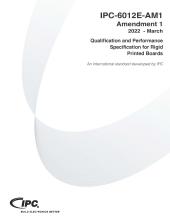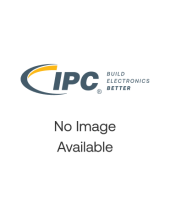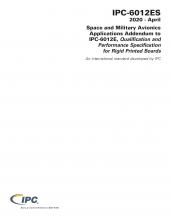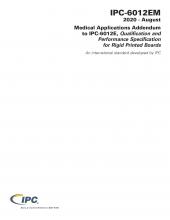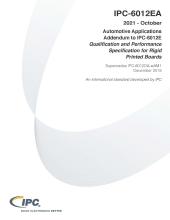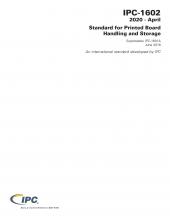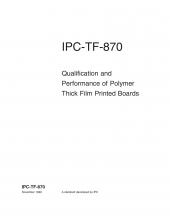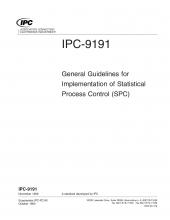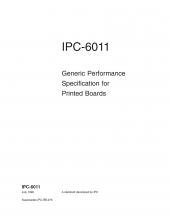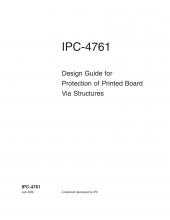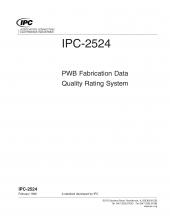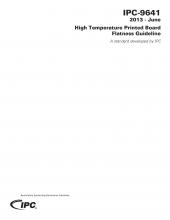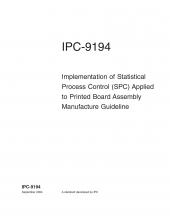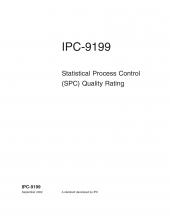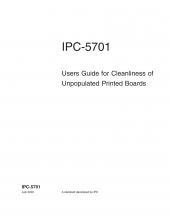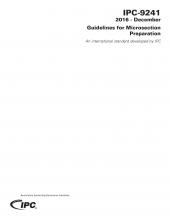Products
IPC-6012E-AM1 is an Amendent to the IPC-6012E that clarifes the distinction between receding and dewetting solder in reflowed SPb or HASL coatings. The Amendment also provides amended criteria for minimum external conductor thickness of the finished printed board and new acceptance criteria for the minimum thickness of internal plated layers
Amendment 1 to IPC-7711/21C, the document provides procedures for removal and installation of D-Pak components
The IPC-6012ES space addendum provides exceptions to Class 3 requirements of the IPC-6012E for use in space and military avionics product. Exceptions include changes to acceptance criteria and/or sample size and test frequency for production lot acceptance testing. The IPC-6012ES covers requirements for rigid printed boards to survive vibration, extreme thermal cycling and ground testing...
The IPC-6012FS space addendum provides exceptions to IPC Performance Class 3 requirements of the IPC-6012F for use in space and military avionics product. Exceptions include changes to acceptance criteria and/or sample size and test frequency for production lot acceptance testing. The IPC-6012FS covers requirements for rigid printed boards to survive vibration, extreme thermal cycling and ground...
The IPC-6012EM Addendum, when required by procurement documentation/drawings, supplements or replaces specifically identified requirements of IPC-6012E, for rigid printed boards that must meet requirements to high reliability medical device applications. IPC-6012EM is the only global industry-consensus standard for Medical Applications to Qualification and Performance Specifications for Rigid...
The IPC-6013EM Addendum, when required by procurement documentation/drawings, supplements or replaces specifically identified requirements of IPC-6013E, for flexible/rigid-flexible printed boards that must meet requirements to high reliability medical device applications. IPC-6013EM is the only global industry-consensus standard addendum for Medical Applications to Qualification and Performance...
The IPC-6012EA Addendum, when required by procurement documentation/drawings, supplements or replaces specifically identified requirements of IPC-6012 revision E, for rigid printed boards that must survive the vibration and thermal cycling environments of electronic interconnects within the automotive industry. The addendum includes updated requirements for lifted lands, pattern feature accuracy...
The IPC-1602 standard provides requirements intended to protect printed boards from contamination, physical damage, solderability degradation and moisture uptake. Consideration is given to packaging materials types and methods, production environment, handling and transport of product, and establishing baking profiles for moisture removal. IPC-1602 is now providing requirements that can be called...
Contains over 150 industry approved test techniques and procedures for chemical, mechanical, electrical, and environmental tests on all forms of printed boards and connectors. New and updated test methods are available for download at https://www.ipc.org/test-methods.
IPC-6012F Redline document shows the changes from IPC-6012E to IPC-6012F in a side-by-side comparison of the two documents. The IPC-6012F redline is available in both electronic and hardcopy format.
Covers the materials, qualification, certification and performance requirements for multilayer polymer thick film (PTF) printed, extrusion deposited, or otherwise applied conductor, insulator and through-hole technology. This specification may also be used for procurement of single and double-sided boards. 59 pages. Released November 1989.
This voluntary standard establishes minimum requirements for the design, installation, operation and maintenance of electrically heated process equipment in order to minimize electrical hazards and prevent fires that may occur in combustible tanks, tank liners and drying equipment.
IPC-1756 establishes the requirements for exchanging manufacturing data between suppliers and customers for electrical and electronic products. IPC-1756 establishes 23 fields for declaration of manufacturing data supported by Scriba and other tools developed for use between users and suppliers. The type of manufacturing information includes sensitivity to moisture and high temperature, different...
IPC-9191 reflects the principals of statistical process control (SPC) represented by ISO/DIS 11462-1, Guidelines for Implementation of Statistical Process Control (SPC) -- Part 1: Elements of SPC. This document outlines the SPC philosophy, implementation strategies, tools, and techniques used for relating process control and capability to final product requirements. Supersedes IPC-PC-90.
This specification establishes the general requirements and responsibilities for suppliers and users of printed boards. Serving as the foundation for the IPC-6010 Board Performance Documents series, it describes quality and reliability assurance requirements that must be met. For use with IPC-6012 through IPC-6018. Supersedes IPC-RB-276, IPC-SC-320, IPC-TC-500, IPC-ML-950C. 15 pages. Released July...
IPC-4761 is the sole industry guideline providing PCB designers, manufacturers and uses with detailed information on all existing methods for protecting vias on printed boards, including all types of via tenting, plugging, filling and capping. Production issues, long term reliability concerns and material specification and selection are provided to aid in evaluating the benefits and concerns for...
This document describes a PWB fabrication data quality rating system used by fabricators to evaluate incoming data package integrity. Includes information on conformance to both fabricator and customer design rules and can be used by printed board designers as an output quality check. 16 pages. Released February 1999.
Printed board flatness is largely affected by a change in intrinsic properties through exposure to variances in temperature. The worst case deviation of the printed board from flatness may be at room temperature, peak temperature during reflow, or at any temperature in between. Printed board flatness must therefore be characterized during the entire reflow thermal cycle, and not solely at room...
This redline provides a side-by-side comparison the changes from Revision C to Revision D of IPC-7711/21.
This guideline standard is intended to aid in interpretation of the requirements in IPC-9191, "General Guidelines for Implementation of Statistical process Control," specifically for printed board assembly (PBA) manufacture. This document and IPC-9191 should be used together; the standards are cross-referenced to each other in the Appendices of this guideline. This standard promotes process...
This document is a tool for a customer or supplier organization's internal audit group to assess a statistical process control (SPC) system against the requirements of IPC-9191. This document should be used by customers and suppliers of any size and for any commodity. This tool can be used to perform an assessment of the use of SPC at both organizational and process levels. The questions in this...
Tackling PCB cleanliness is a tough job; residues on printed circuit boards are directly related to the reliability of the produced hardware and can result in serious failures if not known or monitored. But how do you measure "cleanliness"? How clean is "clean"? The IPC-5701 provides guidance into how these issues should be approached and specified in purchasing documents, addressing levels of...
This specification covers qualification and performance requirements of rigid mass laminated panels for use in multilayer printed boards. Testing procedures and criteria are addressed. 21 pages. Released July 1994.
Discusses the many variables and problems associated with the process--from sample removal to micro-etch-- and the variables common to high volume microsection. The process variables and problems are organized so that the reader can research a specific issue or overview the variables of a process area. 31 pages. Released October 1993.
This standard is intended as a guideline in the proper preparation of a metallographic sample (microsection) of a printed board. The finished microsection is used for evaluating the quality of the laminate system and plated structures (e.g. PTHs and vias). Microsection sample preparation is regarded by many as a highly developed skill. The guidelines in this standard discuss the many variables and...
Coming Soon
IPC-7095E: Design and Assembly Process Implementation for Ball Grid Arrays (BGAs)
IPC-7530B: Guidelines for Temperature Profiling for Mass Soldering Processes (Reflow & Wave)
IPC-2294: Design Standard for Printed Electronics on Rigid Substrates
IPC-6904: Qualification and Performance Specifications for Printed Electronics on Rigid Substrates
IPC-4105: Specification for Metal Base Copper Clad laminates for Rigid Printed Boards

